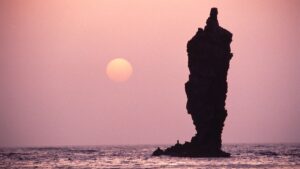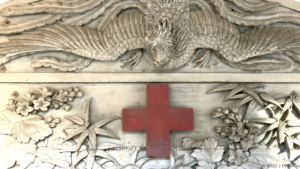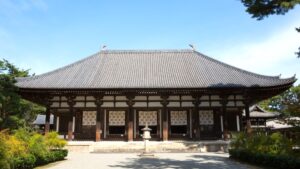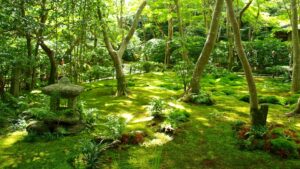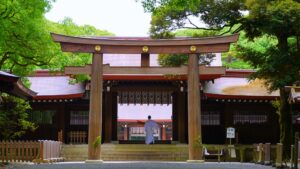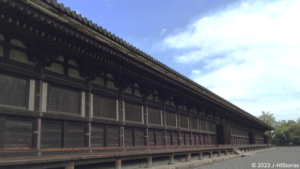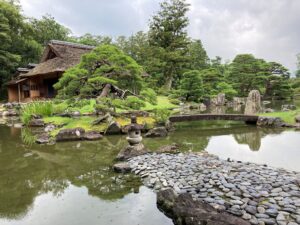Kyoto Imperial Palace, Successive Emperor's Residence
The Heian-kyo had been the center of the nation where the successive emperors resided for over 1200 years since the capital relocation from Nara in 794 by the 50th Emperor Kanmu until 1869 when Emperor Meiji moved to Tokyo, one year after the Meiji Restoration. The highlight is the beautiful Shishinden Hall with its cypress […]
The Oki Islands, The Exile of Emperor Go-Toba by Samurai: A Political Drama in Medieval Japan
A 50-minute flight from Itami Airport in Osaka, the Oki isolated Islands in Shimane Prefecture, a UNESCO World Geopark, are blessed with abundant nature. Since ancient times, the islands have been called the "Islands of the Deities." Japan's oldest books, Kojiki and Nihonshoki, describe the creation of the Oki Islands by two deities, Izanagi and […]
Yoshino Jingu Shrine and Yoshimizu Shrine: The Heart of the Southern Court, Dedicated to Emperor Go-Daigo
In spring, Mt. Yoshino is adorned with approximately 30,000 cherry blossoms in full bloom, comprising about 200 different varieties of Yamazakura, mountain cherry blossoms, gradually reach full bloom in four areas - Shimo, Naka, Kami, and Oku – ascending from the base to the summit, taking about a month to unfold fully. The panoramic view […]
Sakuradamon Gate of Edo Castle ruins with beautiful cherry blossoms: Ii Naosuke lost his life
The stunning sight of cherry blossoms in full bloom reflecting on the water of Chidorigafuchi moat of the former Edo Castle, now the Imperial Palace, is breathtaking. Its beauty leads to the Sakuradamon gate, where a startling event occurred under a cold sky with heavy snowfall in 1860 for the Tokugawa Shogunate. Ii Naosuke (1815-1860; […]
Museum Meiji-Mura: Japan Red Cross Society Central Hospital, A Symbol of Relief Work in Peacetime
One of the wards of the Japanese Red Cross Central Hospital, delicately adorned with its exquisite exterior and state-of-the-art facilities, has been relocated to the Museum Meiji-Mura. Sunlight streams in through the glass wall of the corridor, and the long, straight, boarded corridor maintains a sense of pristine cleanliness. This wooden architecture exudes the esteemed […]
The Legacy of Toshodaiji Temple: Ganjin’s Epic Voyage to Japan
Toshodaiji Temple, a UNESCO World Heritage Site, was founded by Ganjin or Jianzhen (668-763, 鑑真) in 759 as a center for Buddhist training when Asuka (present-day Nara) was Japan’s capital. In 733, during the reign of the 45th Emperor Shomu (701-756, 聖武天皇), two young Japanese monks named Yoei and Fusho embarked on a mission to […]
Saihoji (Moss Temple): The pinnacle temple created by Zen Priest and Garden Designer, Muso Soseki
The ultimate beauty of nature's formations Saiho-ji, a UNESCO World Heritage Site, known as the Moss Temple, is a Rinzai Zen Buddhist temple that held a special place in Steve Jobs’ heart, drawing him to visit it several times. This enchanting temple boasts a 5,000 square meter garden adorned with approximately 120 distinct varieties of […]
Meiji Jingu Shrine: An Amazing Green Forest to Commemorate the Virtues of Emperor Meiji
Meiji Jingu Shrine is located in the center of Tokyo to enshrine the spirit of Emperor Meiji and Empress Shoken. It has a variety of wild animals, bugs, butterflies, fungi, 234 kinds of trees, 352 kinds of plants, and more than 100 kinds of birds in the forest which is blessed with a breath of […]
Who Built Sanjusangen-do Hall and What does Sanjyusan mean?
The Sanjyusangen-do Hall (literally 33 intervals), officially Rengeoin Temple, resides in the heart of Kyoto. Constructed in 1164 by the retired Emperor Go-Shirakawa (1127~1192, 後白河天皇), or Go-Shirakawa-In, with the financial support of Samurai, Taira Kiyomori, to pray for the safety and prosperity of the nation and people. This remarkable 121-meter-long wooden structure features 33 spaced […]
The Katsura Imperial Villa, authentically beautiful architecture
Situated in the southern province of Kyoto, along the picturesque Katsura River, the Katsura Imperial Villa, a masterpiece of beauty, served as a detached villa of two aesthetic crown princes: Prince Toshihito (1579~1629, 八条宮智仁親王) and his son, Prince Toshitada (1619~1662, 八条宮智忠親王). Its construction started in 1628 and was completed in 1658 during the transition from […]


